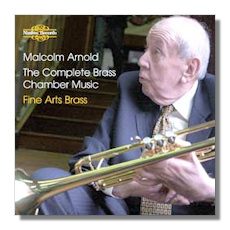
The Internet's Premier Classical Music Source
Related Links
-
Find CDs & Downloads
Amazon - UK - Germany - Canada - France - Japan
ArkivMusic - CD Universe
Find DVDs & Blu-ray
Amazon - UK - Germany - Canada - France - Japan
ArkivMusic-Video Universe
Find Scores & Sheet Music
Sheet Music Plus -
Search Amazon
Recommended Links
Site News
Malcolm Arnold
Fantasy for Trombone
Performance Notes
My comments are general. Either you have the technique for this thing or you don't. I've been struggling with it for a long time.
Malcolm Arnold was a very interesting, emotional man, who suffered from melancholy and drinking issues that you can hear in his music under, alongside, etc. passages of jocularity. Some of his later works were almost entirely sad and angry. The Ninth Symphony makes Mahler sound cheerful. The Trombone Fantasy (one of a series written for all or most of the orchestral instruments) sounds like a kind of "bipolar" work. It was written in 1969, when Arnold was living on Cornwall and away from a city, which was unusual for him. His life at Cornwall was a mixed bag. Toward the end of the decade while he was there, he was dealing with his depression and the autism of his son.
Obviously, the outer parts of the Fantasy are humorous, even jolly. But there is certainly a mournful quality to the slow section that needs to be brought out. Difficult as all these fantasies are, Arnold was for a while principal trumpet of the London Philharmonic, so he knew what great brass players were capable of – and these pieces were intended to be played by very strong players. There are three recordings I know of. Mark Lawrence (D'Note 1012), which I have not heard, and two I do know and recommend: Katy Pryce on a disc devoted to Arnold brass music (The Complete Brass Chamber Music, Nimbus NI5804), and Daniel Stettner on an old recording made when he was in the Oklahoma City Symphony and featuring the players from that trombone section. There is also a rather over-the-top performance by Joe Alessi on You-Tube.
It's pretty clear what is going on musically. The first part is jocular, like circus music. It can be played bumptuously or gracefully. It doesn't have to be fast – the given 112 marking works, or maybe a little slower – and it pays to exaggerate the dynamics. There are a lot of approaches you can take with phrases, emphasizing downbeats (my choice) or sometimes upbeats, being aware of accents, that sort of thing. I've always found the measures 7-9 after B interesting as far as phrasing is concerned. I think of the Bb-G at the end of bar 7 as an echo to the phrase just concluded, the next measure-and-a-half as a kind of transition where you can get a little seasick if you want, and what follows as a new phrase. Stettner plays it that way. With Pryce there's a little problem. Either she plays right through the quarter rest at measure 8, or there's a bad edit there. You might try throwing a gliss in between the F# and G between the 6th and 7th measures after A. It's hard to describe the effect you want at four before C. You should pick up on it easily enough. After a long crescendo, it is kind of a recap – with a long decrescendo.
The slow section is rather mournful and sad and should be played that way. Arnold's tempo is slow, and it works, as do his soft dynamics – you can't be soft enough at the end – like a whispering wind dissipating over the sea at night. I can hear the seascape off Cornwall and Arnold's melancholy, as well, in this movement. Listen to one of his first six symphonies' slow movements to get an idea of the style. One interpretive stroke typical of Arnold occurs with those dropping full-step half notes. Weigh on the first one each time just a bit, like a sigh or sob. That same effect occurs in the octave drop 9 after D. Also slightly bring out the Ab 7 after D, same with the flats three after E. Think of 5 after E as a sad echo. Stettner's good here, but Pryce's more rounded sound catches the Cornwall mist even better, though I think the phrasing can be even more mournful than either plays it.
As I understand it, the tempo of the last section, 126, is controversial. I've always been glad to hear that because it's hard! In this area, I'm no help. I don't know how fast Lawrence is here. Dan Stettner is about 104-108 and seems to be single tonguing; Katy Pryce comes in at 120, but speeds up at the Piu Mosso, and seems to be double-tonguing (and very well). Both approaches and speeds work. Beyond that, this movement is all about lightness, agility, and dynamic contrast. Think of the FFs as fanfares, the pps (very soft) as mocking reflections. I take a break before H. Stettner does too. Pryce does not, but where does she breathe? A splice? No idea. Finally, the transition from the high Db to the D. The notes are slurred. Stettner breathes between the two, Pryce does not. Both work. And Pryce's speed really creates the tumbling down effect of the final arpeggios. Count carefully on those low half notes and don't hurry them. And don't just rush through the final 16th notes. Keep the rhythm.
Copyright © 2008 by Roger Hecht.














